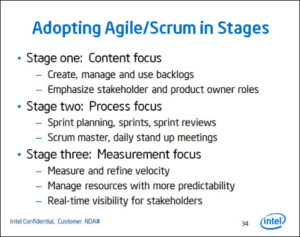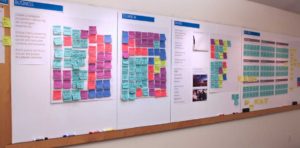I first experienced Agile methodology at Flip (acquired by Cisco) in 2008. I was a follower. We hired a new engineering director who insisted on Agile. I was skeptical but soon converted. With Agile, our organization of 200 people immediately improve d focus and virtually eliminated unimportant, low-priority efforts. We developed our own customized version of Agile Scrum and managed to improve our software deliveries.
d focus and virtually eliminated unimportant, low-priority efforts. We developed our own customized version of Agile Scrum and managed to improve our software deliveries.
Starting at Intel in 2011 there was no doubt I would build my organization for Agile. I quickly encountered resistance and doubt. My team was responsible for camera software on Intel’s mobile architecture. Intel had thousands of people developing Android mobile phones and tablets using 100% waterfall approach. Many people told me there was no place for Agile. Some criticism was very intense.
 As a new leader, I was required to host a 2-day face-to-face meeting within 3 weeks of my start date. Attendees traveled from North America, Europe and Asia to attend. I had to present my strategy, milestones, organizational structure and execution methodology. I needed to present – and gain acceptance – for our Agile approach. I decided to distill Agile into fundamental terms and a three-stage approach.
As a new leader, I was required to host a 2-day face-to-face meeting within 3 weeks of my start date. Attendees traveled from North America, Europe and Asia to attend. I had to present my strategy, milestones, organizational structure and execution methodology. I needed to present – and gain acceptance – for our Agile approach. I decided to distill Agile into fundamental terms and a three-stage approach.
My audience could relate. I met with some success. Managers using waterfall could understand that stage one focused on specifications composed by product requirements and engineering resource responses. They could understand that a product owner was essentially a product manager who owned responsibility for the sum of all the requirements and responses. Stakeholders were the arbiters who approved all product decisions.
The waterfall managers had trouble accepting stage two. Sprint planning and sprints were anathema. Planning for one sprint at a time was inadequate when a full project plan was required. Dividing the team’s work into sprints seemed unnecessary when you could make a detailed Gantt chart where each thread would have it’s own asynchronous milestones. The scrum master role was not understood. The idea of daily standups was met with almost haughty derision.
Stage three was accepted intuitively, but I couldn’t show proof. I don’t believe new Agile teams can reach stage three until the fourth, fifth or sixth sprint. Three weeks into the job I could only promise predictable deliverables and real-time visibility for stakeholders.
 For better or worse, we barged ahead. Throughout my career I’ve never shied from taking risks and attempting to convince non-believers. We could have retrenched back to waterfall and reduced doubt but I swear by Agile.
For better or worse, we barged ahead. Throughout my career I’ve never shied from taking risks and attempting to convince non-believers. We could have retrenched back to waterfall and reduced doubt but I swear by Agile.
We learned a lot. The three phases became the seed for “Agile Agile” approach which embodies an “Agile approach to adopting Agile methodologies”. It’s been an interesting ride.
In upcoming posts, I’ll write about the lessons we learned. First, how to better relate Agile to waterfall management. Second, adding more intermediate stages that foster more solid results and better information for stakeholders. Third, some recommended tools for Agile management.
